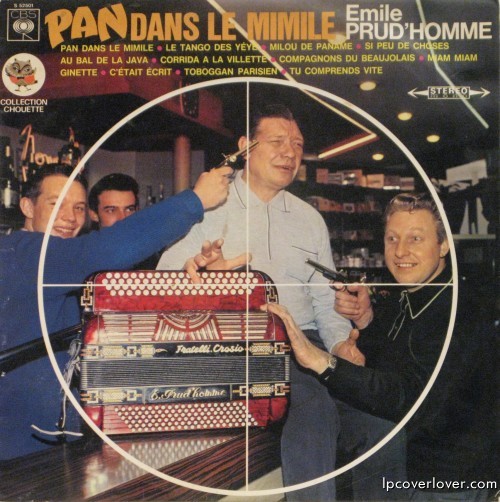Don’t shoot the accordion player

Emile Prud’homme “Pan dans Le Mimile” CBS France
You are currently browsing the archive for the Strange Instruments category.
“Music From Mathmatics” Played by I.B.M. 7090 Computer and Digital to Sound Transducer. Decca Records From the liner notes:
The course of human development has always been marked by man’s striving for new techniques and tools in pursuance of a better life. This is most dramatically manifested in the fields of science and technology. But this dissatisfaction with available materials and methods and the corresponding search for new ones is also evident in the arts, and artists have continually sought to improve the tools of their trade. Today’s modern orchestral instruments, for example, hardly resemble their medieval ancestors. On this recording, we illustrate another advancement in the realm of tools available to the music-maker: the computer and the digital-to-sound transducer. This new “instrument” combination is not merely a gadget or a complicated bit of machinery capable of producing new sounds. It opens the door to the exploration and discovery of many new and unique sounds. However, its musical usefulness and validity go far beyond this. With the development of this equipment carried out at the Bell Telephone Laboratories, the composer will have the benefits of a notational system so precise that future generations will know exactly how the composer intended his music to sound. He will have at his command an “instrument” which is itself directly involved in the creative process. In the words of three of the composers whose works are heard on this recording:
Man’s music has always been acoustically limited by the instruments on which he plays. These are mechanisms which have physical restrictions. We have made sound and music directly from numbers, surmounting conventional limitations of instruments. Thus, the musical universe is now circumscribed only by man’s perceptions and creativity.
The process of composing music on and for the computer and transducer is highly complex: we shall attempt here only a brief and simplified description so that the listener may better understand what he is hearing. At the very heart of this type of composition rests this fundamental premise: “Any sound can he described mathematically by a sequence of numbers.” Our composer thus begins by determining what numbers specify the particular sounds in which he is interested. These numbers are then punched on IBM cards: the cards are fed into the computer and the digits recorded in the memory of the machine. The computer is thus able to generate limitless sounds, depending on the instructions given it by the composer. The latter, instead of writing the score in notes, programs his music by punching a second set of IBM cards, which when fed into the computer cause it to register on tape certain sounds from its vast storehouse. The composer may give the computer detailed instructions for every “note,” or he may allow it varying degrees of freedom by asking it to select “notes” at random from a host of possibilities. The tape which emerges from the computer contains music in the form of magnetic impressions. To convert these impressions to actual sounds, the tape is run on a digital-to-sound transducer, which translates the digital indications to sounds, amplifies these sounds, and gives us the finished musical product.
As can be gleaned from the above description, the human element plays a large role in computer music, as in any art medium. The sounds and sound-producing methods are new; the composer’s role is essentially that which it has always been. History tells us that whenever a new concept emerges, it is labeled revolutionary by either its proponents or the public at large. The new techniques and tools of computer music are not meant to replace the more traditional means of composition and performance. Rather, they are designed to enhance and enlarge the range of possibilities available to the searching imagination of musicians. Science has provided the composer with new means to serve the same ends – artistic excellence and communication.
Jazz harpist, Dorothy Ashby on Argo Records. After successfully integrating the harp into the hard bop and jazz funk idioms of the sixties, Ashby spent the next decade as an LA studio player on sessions with Stevie Wonder, Diana Ross, Earth, Wind and Fire and others. Acid jazz DJ’s picked up on her early recording on Cadet and have sampled her stuff. This one is here for the striking and artistic cover photo of her hands plucking the strings. And you thought getting an upright bass to gigs is tough!